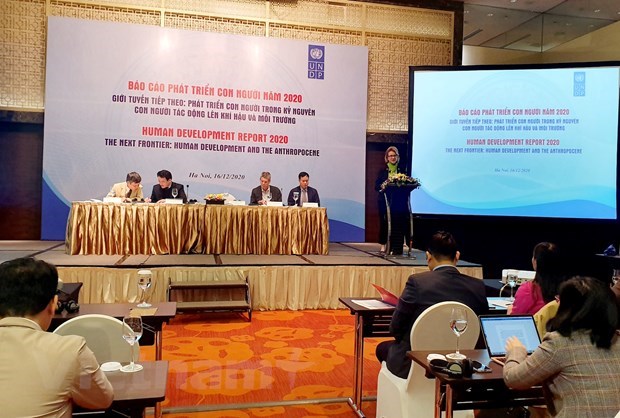Vietnam breaks into high human development category group for first time
Vietnam has joined the ranks of countries in the world with high human development, but this remarkable progress has been accompanied with relatively high pressures on the planet.
 Illustrative image (Photo: VNA)
Illustrative image (Photo: VNA) Hanoi (VNA) - Vietnam has joined the ranks of countries in the world with high human development, but this remarkable progress has been accompanied with relatively high pressures on the planet.
These are among the key findings of the 2020 Human Development Report “The next frontier – Human Development and the Anthropocene,” released in Vietnam today by the United Nations Development Programme (UNDP) in cooperation with the Ministry of Planning and Investment.
The Anthropocene - or The Age of Humans - refers to the new geological age we are living in where for the first time instead of the planet shaping humans, humans are shaping the planet.
Inequality in Vietnam at low level
Addressing the report launch, UNDP Resident Representative Caitlin Wiesen praised Vietnam for embarking firmly on people-centered development and prioritizing human development and equality in its socio-economic development strategies and plans.
Vietnam’s human development index (HDI) value for 2019 is 0.704, putting the country in the high human development category and positioning it at 117 out of 189 countries and territories. Between 1990 – 2019, the country’s HDI value increased by almost 46 percent, which is among the highest HDI growth rates in the world. During the same period, Vietnam’s GNI per capita increased by more than 370 percent.
Notably, Vietnam’s Human Development progress has been achieved with moderate and stable levels of inequality. Its loss of HDI value due to inequality in 2019 is 16.5 percent, its loss of income due to inequality is 19.1 percent and, its GINI coefficient at 35.7 -- are among the lowest in the East Asia and Pacific region. In fact, when considering the country’s Inequality Adjusted HDI, the country is 10 places higher than its HDI ranking in 2019.
Vietnam has also been performing well in terms of gender equality. With the Gender Development Index value of 0.997, Vietnam ranks 65th out of 162 countries and is the highest among five country groups. Particularly commendable is the share of seats in parliament which places Vietnam among the top third of countries globally. However, Vietnam still facing gender inequality challenges: the country ranks in the bottom third globally in terms of sex ratio at birth (1.12), violence against women by intimate partners (34.4 percent) and women with accounts in financial institutions or with a mobile money service provider (30.4 percent). Disaggregated data show larger disparities within geographical locations and ethnic minority groups.
On the quality of Human development, Vietnam performs well on health, education, employment and rural development indicators. Vietnam is among the top third of countries in terms of lost healthy years as a percentage of expectancy (11.7 percent), and number of hospital beds (32 beds/100,000 people). All primary school teachers are trained, rural electrification covers 100 percent of the population and the unemployment rate is low.
 Prime Minister Nguyen Xuan Phuc meets female leaders and National Assembly deputies (Photo: VNA)
Prime Minister Nguyen Xuan Phuc meets female leaders and National Assembly deputies (Photo: VNA)However, Vietnam is within the bottom third in terms of vulnerable employment (54.1 percent) because of the large share of the labour force dependent on self-employment in household businesses.
Vietnam still facing gender inequality challenges: the country ranks in the bottom third globally in terms of sex ratio at birth (1.12), violence against women by intimate partners (34.4 percent) and women with accounts in financial institutions or with a mobile money service provider (30.4 percent). Disaggregated data show larger disparities within geographical locations and ethnic minority groups.
Deputy Minister of Planning and Investment Tran Quoc Phuong praised the Human Development Index (HDI) report for introducing a new experimental index on human progress that takes into account countries’ carbon dioxide emissions and material footprint - planetary-pressures adjusted HDI (PHDI).
With the index, Vietnam, as one of the countries hardest hit by climate change, will have additional orientation foundation to issue and implement policies in response to environmental pollution and climate change, Phuong added.
High pressures on the planet
According to the new report, the COVID-19 pandemic is the latest crisis facing the world, but unless humans release their grip on nature, it won’t be the last. Therefore, the report introduces a new experimental index on human progress that takes into account countries’ carbon dioxide emissions and material footprint - planetary-pressures adjusted HDI (PHDI).
The report lays out a stark choice for world leaders - take bold steps to reduce the immense pressure that is being exerted on the environment and the natural world, or humanity’s progress will stall.
 UNDP Resident Representative Caitlin Wiesen speaks at the report launch (Photo: VNA)
UNDP Resident Representative Caitlin Wiesen speaks at the report launch (Photo: VNA)Addressing the report launch, UNDP Resident Representative Caitlin Wiesen praised Vietnam for embarking firmly on people-centered development and prioritizing human development and equality in its socio-economic development strategies and plans.
“Vietnam’s High Human Development is a remarkable achievement and also creates opportunities for greater and more rapid progress in the coming development period. The country is at a critical juncture as it designs its next Socio-Economic Development Strategy, with decisions made today determining whether it will continue on it current path of growth and low inequality, and whether it can simultaneously shift to reducing pressure on the planet to enhance the harmony of the people and the environment,” said Ms. Wiesen. “I would like to reaffirm that UNDP stands ready to partner with Vietnam in this journey to redesign a path to progress that respects the intertwined fate of people and planet.”
Vietnam’s remarkable human development has been accompanied with high pressure on the planet. In 2019, Vietnam’s HDI value falls from 0.704 to 0.664 or a loss of 5.7 percent due to carbon dioxide emissions and material consumption per capita.
Vietnam performs well in terms of forest coverage and response to disasters, but is among the bottom third of countries in terms of carbon emissions per unit of GDP, land degradation (31 percent of the total land area), red list index (a measure animal extinction), and use of fertilizer nutrients per hectare of cropland (136.5kg Nitrogen & 65.1kg Phosphorus)./.













